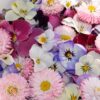
Everything is better with tea.
Unknown
After water, tea is the most consumed beverage in the world. While this statistic is based on “common” tea -from Camelia sinensis, there has been an increase in drinking of herbal teas worldwide as the global trend of consumer interest in natural health and wellness lays the foundation for herbal tea’s increased popularity.
Extracting herbal flavour and benefits with water is one of the oldest ways to enjoy herbs. Drinking herbal tea can be either a pleasure simply in enjoying the taste of the brew, or herbal tea can be taken for the particular healing benefit of the plants chosen to infuse. Whether you are interested in expanding your beverage repertoire, or keen to delve into natural home remedies, herbal teas are a fascinating topic to explore.



Tea vs infusion vs decoction
Herbal teas and infusions are made from the softer aerial parts of plants – leaves & flowers, while herbal decoctions are made from the harder plant parts such as seeds, bark, roots, and dried berries or nuts.
- An herbal tea is made with less plant material, steeped for a shorter time, in warm water, and often made cup-by-cup to be enjoyed immediately. E.g., 2tsp dried chamomile flowers to 2 cups hot water steeped for 5-10 minutes.
- An herbal infusion is made with more plant material, steeped for a longer period of time, in either hot or cold water, and often made in larger amounts (a litre) at a time. E.g., 45g of nettle to 4 cups of water steeped for 4-8 hours.
An herbal decoction is made by simmering herbs in water for between 30 and 60 minutes, depending on the plant material. E.g., 1Tbsp dandelion root to 1½ cup water simmered for 20 minutes.
Simples vs blends
Herbal teas can be enjoyed as simples, where only one herb is used, or in blends where more than one herb is combined for a particular flavour, or benefit.
How much herb
This is very much a question of personal taste, and the herb used. If you are new to herbal teas, start with a weaker tea, increasing amount of herb and steeping time until you find what works for you. Stronger herbs, like peppermint will need less per cup than herbs that are not as intensely flavoured, like raspberry leaf.
Good practices
• Always use excellent quality herbs
• Use distilled water (not chlorinated water or hard water)
• Let boiled water cool for a minute before using
• Cover the brew while it is steeping with a lid (teapot), or plate (cup) so that the volatile oils released in the steam, condenses back into the tea
• Take the time to enjoy. Making and drinking herbal tea should be an enjoyment, and engagement of all the senses
Minette’s Garden Tea
This is a delicious tea with subtle uplifting and general healing benefits which can simply be enjoyed for its beautiful taste:
A handful of lemon balm (Melissa officinalis) leaves
A few anise hyssop (Agastache foeniculum) leaves
A sprig of lemon verbena (Aloysia triphylla)
Calendula (Calendula officinalis) petals from one flower
Some Borage (Borago officinalis) flowers
Steep in 2 cups of hot water for 10 minutes, strain and enjoy.





